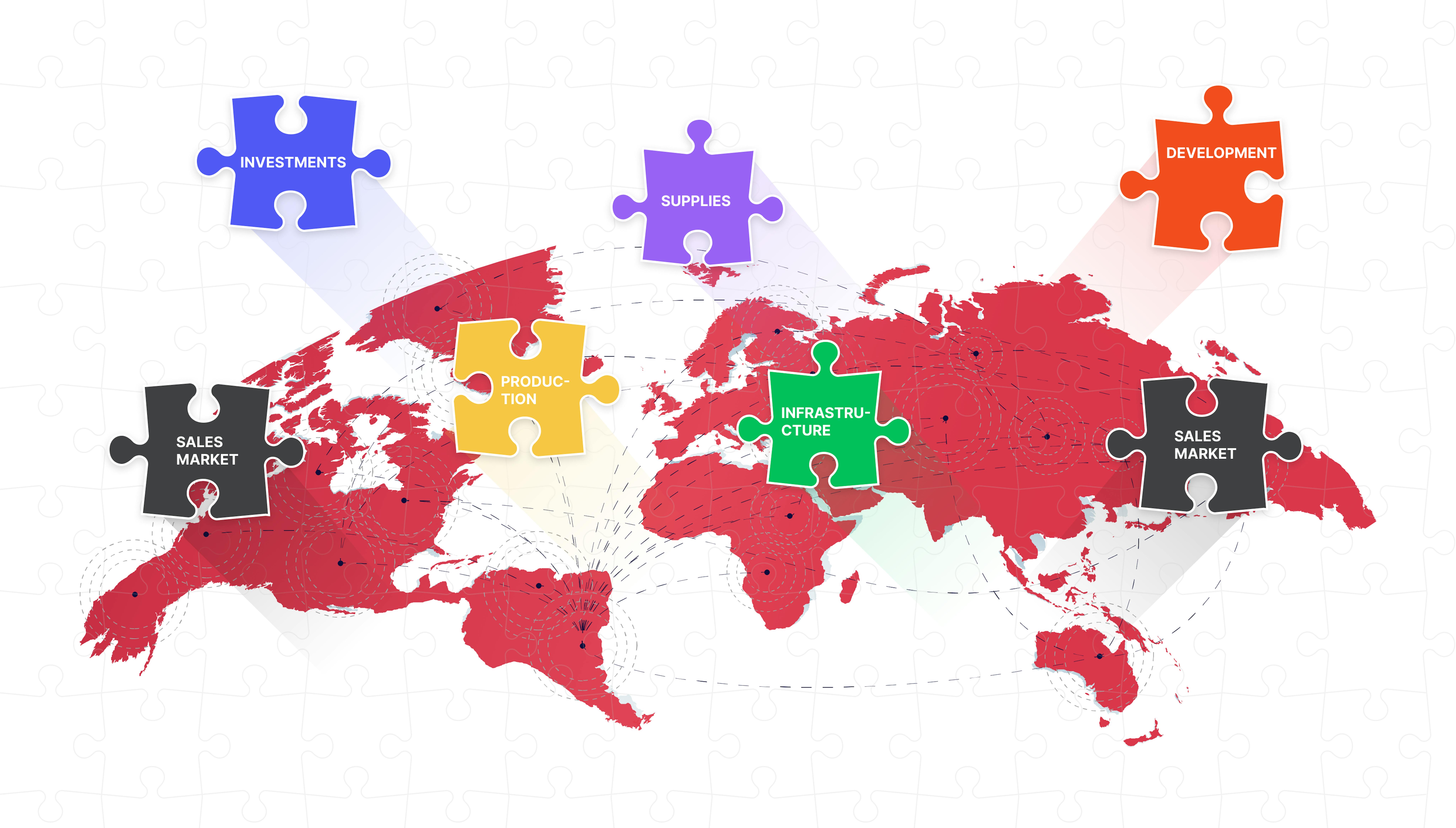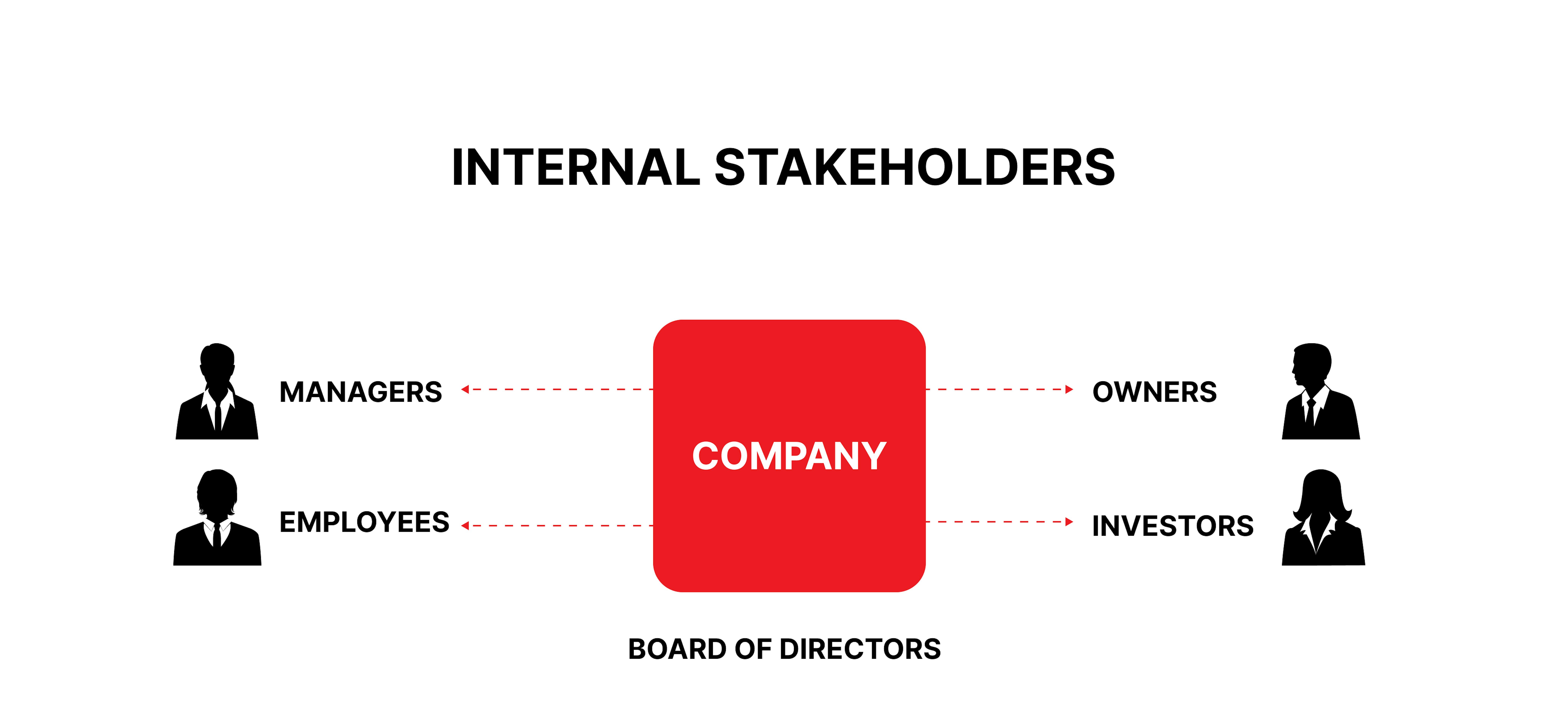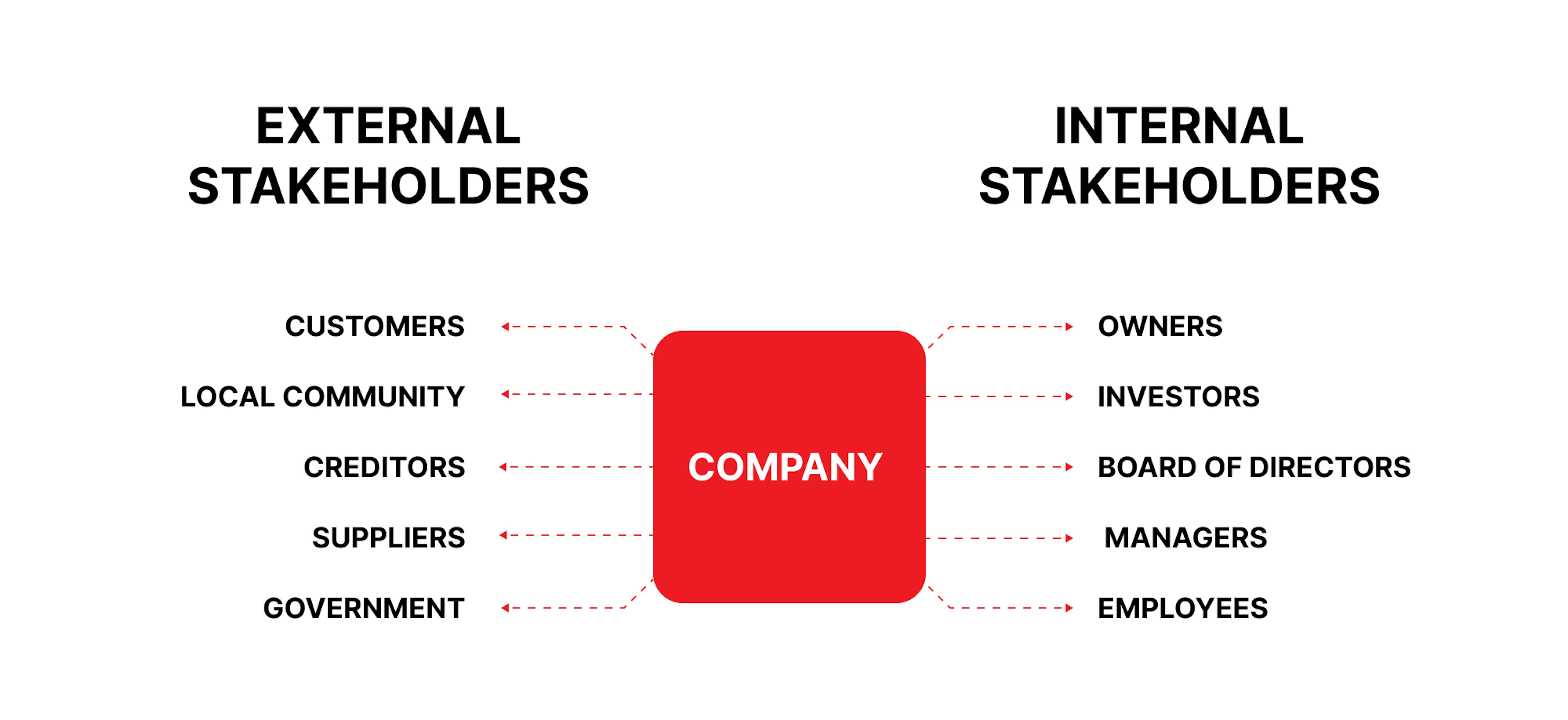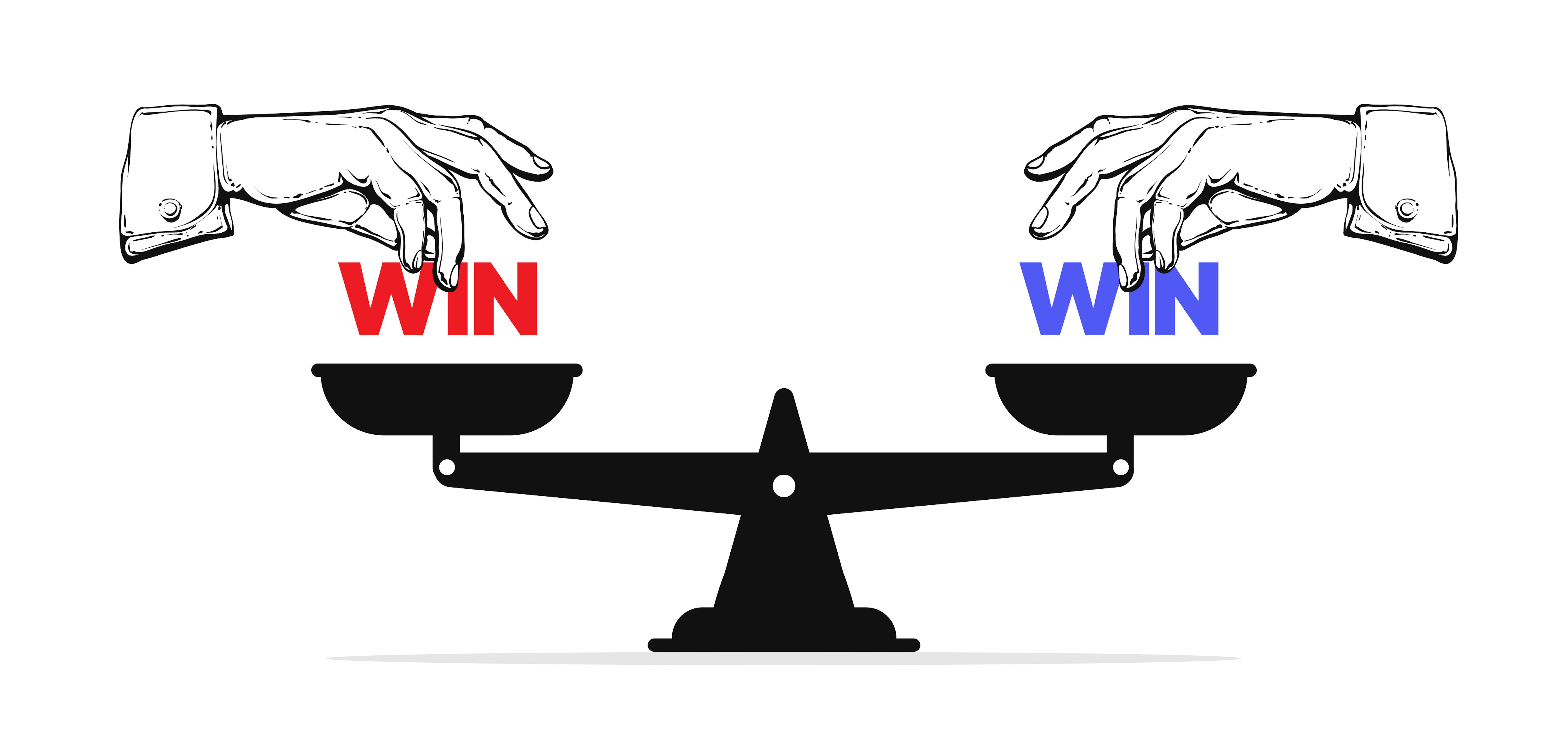According to Deloitte, over 70% of companies now outsource at least one IT function to optimize costs and increase efficiency. As outsourcing and offshore development continue to grow, projects inevitably involve more external and internal stakeholders — from vendors and distributed teams to business leaders and end users.

Traditional project management focused on timelines and deliverables. Today's reality demands a deeper understanding of who influences your project's success and how to align their often conflicting interests. Poor stakeholder management can derail even technically sound projects, while effective stakeholder alignment can turn challenging initiatives into success stories.
Let's explore who stakeholders are and examine the key differences between internal and external stakeholders in IT projects.
What are the stakeholders?
Stakeholders are individuals, businesses, or organizations that have a direct interest in your company's activities and outcomes. They are characterized by two key dimensions: their influence capability — the ability to affect your company's decisions, operations, or success — and their impact exposure — the degree to which they are affected by your company's actions, performance, or changes.
To define and categorize stakeholders more systematically, I rely on official international standards and frameworks. They provide clear criteria for identifying internal and external stakeholders, analyzing their interests, and structuring engagement approaches. Among the most authoritative are:
ISO 10002:2018 — standard provides guidance on managing stakeholders in the context of project management. It includes a definition of stakeholders, as well as criteria for identifying and analyzing them.
Project Management Institute (PMI) Stakeholder Management Standard — provides a comprehensive framework for stakeholder management. It includes a definition of stakeholders, as well as criteria for identifying, analyzing, engaging, and managing them.
International Association for Public Participation (IAP2) Public Participation Spectrum — This framework identifies five public participation levels, from informing to empowering. Each level of participation has different implications for stakeholder involvement.
The terms "stakeholder" and "shareholder" are often used interchangeably, but they have distinct meanings in the business world. Let's break down the key differences:
Stakeholders are individuals or groups with a vested interest in a company’s outcomes. Most are naturally invested in its growth and prosperity, yet some may benefit from its decline or even bankruptcy if that brings financial or competitive advantages. This diverse category encompasses employees, customers, suppliers, investors, communities, the environment, and even competitors. In essence, stakeholders are defined by how the company’s performance and decisions affect their own interests.
On the other hand, shareholders are a specific type of stakeholder. These are individuals or institutions that own shares of a company's stock. Their primary concern is typically the company's financial performance, particularly its stock price and the potential return on investment (ROI).
Generally, stakeholders can be categorized into two groups: internal and external. Let's explore these in more detail and understand the distinct roles they play in business.
What are the internal stakeholders?
Internal stakeholders, also known as primary stakeholders, are individuals or entities that have a direct interest in or influence over a company. Their involvement is crucial because the processes and outcomes of the company directly impact them. Examples of internal stakeholders include employees, owners, and investors.

What is the role of internal stakeholders?
Internal stakeholders have distinct roles in the company, depending on their interests, level of influence in decision-making, and responsibilities. Let's explore these roles in more detail:
Investors
Investors provide the capital necessary for a company to operate and grow. While their influence on daily decisions may be indirect, their interests are a top priority. Investors primarily care about the company's financial performance, as they expect consistent profit generation and steady growth in market value.
Owners
Owners are responsible for the foundation and continued existence of the company. Their involvement in decision-making varies. If they are primarily focused on profitability, they may delegate decision-making authority to the board of directors. However, owners may also take a hands-on role, especially if they want to ensure the company's core values are upheld across all operations, products, and services.
Board of directors
The board of directors is responsible for making high-level strategic decisions that guide the company's direction. They influence all operational aspects and are tasked with ensuring the company's market capitalization grows. The board's primary goal is to satisfy investors' interests and ensure that owners are confident in their management choices, especially in terms of business expansion and leadership.
Managers
Managers oversee the performance of employees and help ensure that departments meet their goals. They play a key role in tactical decision-making, setting departmental objectives, and maintaining a productive work environment. Managers are typically focused on minimizing the risk of downsizing, providing good working conditions, and ensuring fair compensation and bonuses for their teams.
Employees
Employees are responsible for carrying out day-to-day tasks and maintaining high standards of work. While they may not always have direct decision-making power, their feedback can influence task prioritization and process improvements. Employees generally seek job security, stable pay, good working conditions, and opportunities for career growth and bonuses.
📖 How to build transparent work processes, so stakeholders have no questions about where the money was spent? Read Oleg Puzanov's article, where he reasoned about the future of outstaffing and outsourcing and described the new approach to cooperation models — Transparent Remote Staffing
Who are the external stakeholders?
External stakeholders, or secondary stakeholders, have an interest in the company but do not directly influence its decisions or outcomes. Examples of external stakeholders include customers, local communities, suppliers, and various government or financial institutions.

What is the role of external stakeholders?
The role of external stakeholders depends on the nature of their interest and the extent of their influence on the company's ability to produce and distribute its services and products. While they may not have direct control over company decisions, their interests must still be taken into account:
Customers
While individual customers typically don't influence a company's decisions directly, they collectively determine the success of the company by purchasing its products and services. Their needs and preferences, like wanting high-quality and easily available products, are key to the company's growth and success.
Local communities
Local communities may not directly impact company decisions, but their interests can still affect the company. For example, they may organize protests or demonstrations if the company negatively impacts the environment, traffic, or local well-being. Conversely, they may benefit from the company's presence by raising the status of the location, attracting more residents, businesses, and higher rents.
Creditors
Creditors are concerned with the company's financial stability. While they don't influence business decisions, they are motivated by the company's ability to generate consistent income, which enables them to offer larger loans at more favorable terms.
Suppliers
In today's global economy, no company operates in isolation. Companies rely on suppliers for goods and services, and suppliers, in turn, depend on the company's success to maintain a steady flow of orders. Suppliers are therefore invested in the company's growth, as it results in more business, higher profits, and lower production costs.
Government
Governments are invested in the growth of companies because higher profits translate to higher tax revenue. As companies expand, they create more jobs, which boosts the local economy and increases purchasing power. Additionally, when governments provide favorable conditions for businesses to grow, they attract more startups, fostering mutual economic growth and positive trends.
What is the difference between internal stakeholders and external stakeholders?
Now that you know the exact definitions and examples, we can conclude the difference between internal and external stakeholders. Here is a table comparing internal and external stakeholders based on various aspects.
| ASPECT | INTERNAL STAKEHOLDERS | EXTERNAL STAKEHOLDERS |
|---|---|---|
| Role | Part of the company, directly involved in its operations | Represent outside entities with an interest in the company, not directly involved in its core structure |
| Priority | High priority, integral to the company's success | Secondary priority, still important but not integral |
| Influence | Direct influence on resources, processes, and results | Indirect influence, typically through market demand, public opinion, or regulations |
| Interests | Directly affected by the company's activities | More indirect interest may also have interests in competitors |
| Access to information | Direct access to company data, decisions, and performance metrics | Limited access, typically receive filtered information specific to their interests |
Here's a handy visual comparison you can save and refer back to whenever you need:

Recognizing the distinction between internal and external stakeholders is more than categorization—it's about understanding who you're working with. In my experience managing complex IT projects, I've seen how this foundational knowledge shapes every subsequent decision, from communication styles to engagement strategies.
4 proven strategies to manage internal and external stakeholders effectively

Effectively managing stakeholders is key to the success of any project. Whether internal or external, stakeholders play a vital role in project execution. By identifying and categorizing stakeholders, analyzing their needs and influence, and developing tailored communication strategies, you can ensure alignment, build trust, and address concerns proactively. Here are four strategies, structured as a step-by-step process:
1. Identify external and internal stakeholders
The very first step is to identify your internal and external stakeholders. This is the foundational step where you list all the people or groups who can influence or are impacted by the project.
2. Analyze stakeholder needs and influence
Understanding the needs and expectations of stakeholders is crucial. Each stakeholder group may have different priorities, which can directly impact your project's success.
- Assess needs: Research each stakeholder's concerns and expectations related to the project. This will help you align project objectives with their interests.
- Evaluate influence: Determine each stakeholder's influence on the project's success and how critical their support is. Prioritize engagement based on their level of influence and importance.
Tools like a power/interest matrix can help categorize stakeholders into groups based on their influence and interest, ensuring that you focus efforts where they matter most.
How to construct a matrix
Start by plotting your stakeholders on the matrix based on two key factors:
- Importance: How critical is this stakeholder to the success of the project? Are they supportive or opposed?
- Influence: How much power does the stakeholder have to affect the project's outcome?
Then you can divide them into four quadrants, each with specific strategies for engagement:

🔻 Quadrant 1: High influence, high importance
Stakeholders in this quadrant are critical to the success of the project. They have both significant power and a strong interest. These stakeholders should be fully engaged throughout the project. The level of involvement should be high, with regular communication and opportunities for input to maintain their ownership and commitment.
Example stakeholder: CEO and Senior Executives
Why they fit here: These stakeholders have the power to make strategic decisions and are highly invested in the success of the product launch. Their involvement is crucial, as their decisions will impact the overall direction of the project and its success.
🔻 Quadrant 2: High importance, low influence
These stakeholders are highly invested in the success of the project, but they have limited power to affect outcomes directly. They should be kept informed and educated regularly, ensuring their concerns are addressed through tailored communication and updates. This keeps them on board without overwhelming them with the decision-making process.
Example stakeholder: Marketing team
Why they fit here: The marketing team is highly important because they are responsible for promoting the software and ensuring market penetration. However, they have limited influence on the actual development or technical aspects of the product.
🔻 Quadrant 3: Low Influence, Low Importance
Stakeholders in this category are less involved and have minimal impact on the project. However, care should be taken to monitor them and ensure they don't become a source of unfavorable lobbying. While they don't require as much attention, it's essential to maintain open communication and ensure they feel involved enough to avoid any negative perceptions.
Example stakeholder: External Contractors for Non-Critical Features
Why they fit here: These stakeholders are involved in the project, but their influence and impact on the project are minimal. They are responsible for developing non-critical features or tasks that don't directly affect the overall success of the product.
🔻 Quadrant 4: High Influence, Low Importance
These stakeholders can have significant power to affect the project's direction, but their level of interest in the project is low. They should be kept satisfied and occasionally consulted to avoid potential disruptions. Engaging them as supporters or patrons can also be beneficial, ensuring that they feel valued but are not overly involved in the details of the project.
Example stakeholder: Regulatory Authorities (e.g., Data Privacy Regulators)
Why they fit here: Regulatory authorities have the power to halt or delay the product launch if compliance issues arise, but their interest in the project itself is low. They're primarily concerned with whether the product meets regulations, rather than its market success.
By categorizing stakeholders in this way, you can focus your efforts where they'll be most effective. High Influence, High Importance stakeholders should be fully engaged, while High Importance, Low Influence stakeholders need regular updates to ensure alignment. Low Influence, Low Importance stakeholders can be monitored, and High Influence, Low Importance stakeholders should be kept satisfied with minimal involvement.
3. Develop a tailored engagement strategy
Communication is key to managing stakeholders effectively. Tailor your approach to each group:
- Internal stakeholders: They often require detailed updates and discussions. Regular meetings, emails, and collaborative platforms are ideal for maintaining transparency and alignment.
- External stakeholders: These groups may prefer high-level updates and summaries. Use formal reports, presentations, or customer service channels to keep them informed.
Engage stakeholders regularly and involve them in decision-making processes where appropriate. This not only strengthens relationships but also fosters a sense of ownership and commitment to the project's success.
4. Monitor and adapt stakeholder engagement
Stakeholder needs and dynamics can evolve over time. Therefore, it's important to assess the effectiveness of your engagement strategies regularly.
- Monitor engagement: Continuously track how engaged stakeholders are and adjust strategies as needed. Use feedback to identify areas for improvement.
- Celebrate milestones: Acknowledge the contributions of stakeholders by celebrating key achievements, reinforcing positive relationships, and encouraging ongoing collaboration.
At Mad Devs, managing stakeholders is an ongoing and dynamic process, especially when working with remote teams. Remote setups present a unique set of challenges, including time zone differences, language barriers, and organizational disparities.
To overcome these hurdles, we rely on transparent processes and robust collaboration tools. These are essential for keeping all stakeholders aligned, ensuring smooth communication, and driving project success. Below, we share the best practices that we consistently implement to manage these dynamics and maintain strong stakeholder relationships effectively.
💡 You can also get our free consultation if you need more expertise in developing a transparent work process with your stakeholders. We are always ready to provide our best practices for team management.
Stakeholder management in outsourced software development
Outsourcing software development offers businesses greater flexibility, cost-efficiency, and access to specialized talent. However, it introduces a complex web of stakeholders that must be managed with care to ensure project success.
Effective stakeholder management goes far beyond task delegation and deadline tracking. It relies on proactive communication, ongoing engagement, and a deep understanding of their goals and priorities. Here's how we approach it at Mad Devs:
1. Maintain clear communication channels
In outsourced and remote setups, maintaining clear, consistent communication is paramount. Without face-to-face interaction, it's easy for misunderstandings to arise. Weekly standups, real-time reporting, and shared project dashboards help everyone stay aligned and reduce the risk of surprises down the line. At Mad Devs, we utilize Enji.ai to ensure real-time updates and transparency for all stakeholders. The AI-powered platform automatically generates project reports and sends out notifications about milestones, blockers, and delays, allowing internal and external stakeholders to stay aligned without needing constant manual updates.
2. Track engagement based on stakeholder needs
Stakeholder engagement is not static. As a project evolves, the needs and priorities of your stakeholders will shift. It's crucial to track this engagement regularly and adjust your strategies accordingly. Stakeholders that were once passive may become more engaged as the project progresses, while others might need less attention as their concerns are addressed. Using feedback tools, surveys, and direct check-ins, we constantly measure satisfaction levels and refine our approach.
3. Embrace flexibility and agility
Agility isn't just for the development team. Stakeholder management in an outsourced environment benefits from an Agile mindset. We adapt to changing requirements, adjust communication strategies as necessary, and quickly pivot when issues arise. Whether it's shifting a stakeholder's role in the project or altering timelines, flexibility ensures that all parties remain aligned and invested in the project's success.
4. Resolve conflicts early and fairly
Outsourcing brings together people from different organizations, time zones, and cultures. It's only natural that differing interests and opinions will arise. The key is to address conflicts early. We foster a culture of open dialogue, where issues can be discussed and resolved calmly. By finding common ground and offering solutions that serve everyone's interests, we keep the project on track and build stronger relationships.
In one outsourced development project, we had to navigate a disagreement between the development team and an external client about feature prioritization. Using Agile techniques, such as retrospectives, we facilitated an open conversation, clarified expectations, and aligned both parties on the project's goals. This early intervention prevented delays and ensured continued collaboration.
5. Stimulate continuous feedback and iteration
Agile's iterative feedback loops are central to stakeholder management. In every sprint, stakeholders provide feedback, allowing us to refine the product and ensure it meets their needs. This continuous feedback helps us make adjustments and align the product with both client and end-user expectations, particularly important in outsourced projects where stakeholder needs can shift frequently.
During our regular sprint reviews with clients, we demonstrate the latest product increments and gather their input. After every sprint, we adapt the product backlog based on feedback and prioritize adjustments. This iterative process keeps the project dynamic, ensures stakeholder satisfaction, and reduces the risk of misalignment as the product evolves.
6. Celebrate milestones and successes
In outsourced projects, it's easy to focus on deliverables and deadlines, but celebrating key milestones is just as important. Acknowledging contributions, whether from internal teams or external partners, reinforces positive relationships and motivates continued collaboration. Regular celebrations, whether big or small, maintain morale and ensure that everyone feels valued throughout the journey.
By applying these techniques, we build strong, transparent relationships that drive project success. These practical approaches help establish effective stakeholder management in day-to-day operations, but sustainable success requires a deeper foundation.
Principles of stakeholder management
Every effective stakeholder management system, including our approach at Mad Devs, is built on solid principles that guide decision-making and ensure consistency over time. While techniques provide practical steps for daily interactions, principles form the ethical and strategic foundation that makes these actions sustainable and trustworthy.
One of the most widely recognized sets of principles was formulated by Andrew L. Friedman and Samantha Miles in their book Stakeholders: Theory and Practice (1991). More than three decades later, these principles remain highly relevant:
Principle 1
Managers should acknowledge and actively monitor the concerns of all legitimate stakeholders and consider their interests in decision-making and operations.Principle 2
Managers should listen to and openly communicate with stakeholders about their respective concerns, contributions, and the risks they assume because of their involvement with the corporation.Principle 3
Managers should adopt processes and modes of behavior that are sensitive to the concerns and capabilities of each stakeholder constituency.Principle 4
Managers should recognize the interdependence of efforts and rewards among stakeholders and should attempt to achieve a fair distribution of the benefits and burdens of corporate activity among them, taking into account their respective risks and vulnerabilities.Principle 5
Managers should work cooperatively with other entities, both public and private, to ensure that risks and harms arising from corporate activities are minimized and, where they cannot be avoided, appropriately compensated.Principle 6
Managers should avoid altogether activities that might jeopardize inalienable human rights (e.g., the right to life) or give rise to risks that, if clearly understood, would be patently unacceptable to relevant stakeholders.Principle 7
Managers should acknowledge the potential conflicts between (a) their own role as corporate stakeholders and (b) their legal and moral responsibilities for the interests of stakeholders and should address such conflicts through open communication, appropriate reporting and incentive systems, and, where necessary, third party review.

The world of business, however, is constantly evolving. Here's how you can update those principles to reflect contemporary practices:
Proactive stakeholder identification and prioritization
Go beyond just acknowledging stakeholders. Identify all relevant stakeholders through stakeholder mapping, considering factors like power, legitimacy, and urgency. This helps prioritize engagement efforts.
Related source: Freeman, R. E. (2010). Strategic Management: A Stakeholder Approach. Cambridge University Press
Materiality assessment and shared value creation
Identify the most important ESG issues (materiality) that are crucial for both your company and stakeholders. Focus on creating "shared value" by addressing these issues through your business strategies. This aligns business success with positive societal impact.
Related source: Creating Shared Value (2011) by Michael E. Porter and Mark R. Kramer in Harvard Business Review
Risk management with stakeholder impact in mind
Develop a robust risk management framework that identifies, assesses, and mitigates potential risks that could negatively impact stakeholders. Consider environmental, social, and economic risks alongside financial ones.
Related source: ISO 31000:2018 Risk Management Guidelines by the International Organization for Standardization (ISO)
Long-term value creation with sustainability integration
Integrate sustainability principles into your corporate strategy. Consider not just short-term profits but also long-term environmental and social impacts. Align your business goals with the UN Sustainable Development Goals (SDGs) to contribute to a more sustainable future.
Related source: The UN Sustainable Development Goals (SDGs)
Ethical decision-making and transparency for trust building
Uphold strong ethical principles in all business practices and decision-making. Foster a culture of transparency and accountability to stakeholders. Reference resources from the Institute of Business Ethics (IBE) for guidance. This builds trust and strengthens stakeholder relationships.
Related source: What is business ethics by The Institute of Business Ethics (IBE)
Summary
Now that you have a clearer understanding of stakeholder roles and how to manage them, you're better equipped to build an effective hierarchy within your organization. While every company will approach this differently, depending on internal policies, legal considerations, and other factors, it's essential to recognize that, in some cases, customers can hold more influence over decision-making than the company's owners. This can work strategically, as long as it's part of a deliberate and well-planned approach that sets the company apart.
The key to success is ensuring that every interaction creates mutual value. With this understanding, you're now better positioned to foster relationships that drive success for all stakeholders. We share our expertise and insights because we believe that when you succeed, we succeed.
FAQ
What are stakeholders?
Stakeholders are individuals, businesses, or organizations connected to your company, influencing or being influenced by its actions.
What are internal stakeholders?
Internal stakeholders, also known as primary stakeholders, are directly impacted by the company's operations. Examples include employees and owners.
What's the difference between stakeholders and shareholders?
What's the role of internal stakeholders?
Internal stakeholders play various roles based on their interests and influence. For instance, investors prioritize profits, while employees focus on job quality and conditions.
What are external stakeholders?
External stakeholders, or secondary stakeholders, are interested in the company but lack direct influence over its decisions. Examples include customers, local communities, and creditors.
How to manage internal and external stakeholders?
Identify stakeholders, assess their importance and influence, and prioritize engagement efforts accordingly. Utilize models like consultation, negotiation, or partnership based on stakeholder dynamics.
What principles govern stakeholder management?
Principles include acknowledging concerns, open communication, cooperation, fair distribution of benefits, and avoiding activities that jeopardize human rights. Adapt these principles to reflect contemporary practices like proactive identification and sustainability integration.









